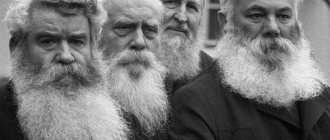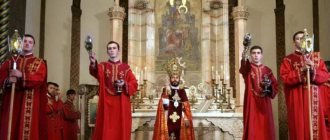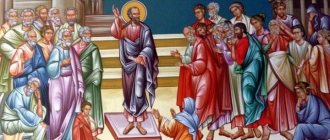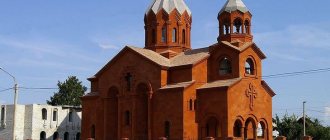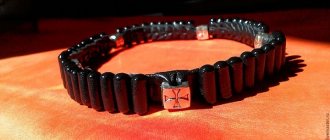The liturgical reform of Patriarch Nikon in the 1650s-1660s caused a schism in the Russian Orthodox Church, as a result of which clergy and laity who disagreed with the new rules of liturgical life separated from the bulk of believers. The Old Believers began to be considered schismatics and were persecuted, often brutally. In the twentieth century, the position of the Russian Orthodox Church in relation to the Old Believers softened, but this did not lead to the prayerful unity of believers. The Old Believers continue to consider their doctrine of faith to be true, classifying the Russian Orthodox Church as heterodox.
Comparison
In the Old Believer Church, the two-fingered sign of the cross is accepted. The perfect and only recognized form of the cross is eight-pointed. Orthodoxy also recognizes four-pointed and six-pointed crosses. Three-fingered sign of the cross. Also, the Orthodox say “Hallelujah” not twice, like the Old Believers, but three times.
three-fingered sign of the cross
In the Old Believer church, some ancient spellings of words and old names are preserved. For example, a monk instead of a hieromonk, Jerusalem instead of Jerusalem.
Old Believers write the name of Christ as Jesus, and Orthodox Christians write I and
sus.
The topmost marks on the cross are also different. For the Old Believers, this is TsR SLVY (King of Glory) and IS XC (Jesus Christ). On the Orthodox eight-pointed cross it is written INCI (Jesus of Nazareth, King of the Jews and IIS XC (I and
sus Christ).
For the Holy Gifts in the Orthodox Church, lamb, special Liturgical bread, is used. It is prepared by the serving priest during the proskomedia. This custom arose around the 9th century, so it is not found in the Old Believer Church.
Icons in the Old Believer church are painted in the traditional Byzantine and Old Russian style. In the Orthodox Church, the influence of Western European painting is noticeable. The Russian Orthodox Church prohibits the production of cast icons. There is no such prohibition in the Old Believers.
In the Orthodox Church, initial and final bows during services are not accepted. During the service, bows are made from the waist, in exceptional cases to the ground.
In the Old Believer church, bows are made at the beginning and end of the service. During the service, it is customary to bow to the ground. All actions of believers are synchronous, which is not the case in Orthodoxy.
Church singing in the Old Believer church is unison, monodic. Chromatic and partes, so-called secular singing, which is accepted in Orthodoxy, is not welcomed. Poglasitsa are widely used in the church reading of the Old Believers.
In the Creed of the Orthodox Church, the opposition between the concepts “born and uncreated”, which was accepted among the Old Believers, has been removed. In the ancient presentation, which is professed by the Old Believers, it sounds like “born, but uncreated.” Also, the Old Believers disagree with the fact that the Holy Spirit should also be confessed as true. In the Orthodox symbol we only read: “True God from true God” regarding the Father and the Son.
In the Orthodox Church, services are performed according to the Slavic Typikon, which was formed on the basis of the Jerusalem Charter. Old Believer services are held according to the Jerusalem Ancient Charter.
The procession around the temple in the Old Believer church is usually performed clockwise, that is, in the direction of the sun. In the Orthodox Church, the procession goes counterclockwise.
In the Old Believer church it is not customary to perform Akathists, except for the Akathist of Praise of the Virgin Mary. Other prayer works that do not have ancient origins are also rejected. There are many akathists in the Orthodox Church. They are served at prayer services and read at home.
Water blessed on the eve of Epiphany is considered the Great Agiasma. In the Orthodox Church this is the name for water blessed on the day of the holiday itself.
Four times a year, on the second, third, fourth and fifth Sunday of Lent, the Orthodox Church celebrates Passion - a special service dedicated to the reading of Gospel texts telling about the passion of Christ. Passion is not celebrated in the Old Believer Church.
Old Believers are a religious movement that arose in Russia in the mid-17th century. during the reform of the Orthodox Church, which was carried out by Patriarch Nikon since 1653.
Old Believers (the term itself appeared in the 19th century) are adherents of the old faith who are opponents of these reforms. A schism arose in the Church at this time. The Old Believers movement was led by Archpriest Avvakum.
The Council of 1666-1667 cursed the Old Belief as “blasphemy against the Lord” and consistently carried out the unification of rituals, books and icons according to the Greek model. Having adopted Christianity through Byzantium in the 10th century, Rus' adopted from the Church of Constantinople both its worship and statutory texts. Over the course of six and a half centuries, many discrepancies in texts and ritual differences arose. During the reforms, newly printed Greek books were adopted as the basis for the new Slavic text. Severe persecution of the Old Believers began. Adherents of the Old Believers founded their monasteries in remote places in the North, the Urals and the Volga region. Over time, the Old Believers themselves split into various formations - agreements and rumors.
Who are the Old Believers?
Christianity came to Rus' in the 10th century from Byzantium. Both statutory church texts and divine services were completely adopted from Constantinople, translated into the language of that time. In addition to rituals and books, the Constantinople school of icon painting also came here.
But over 6 centuries, many ritual innovations arose on Russian lands, and some church books began to be interpreted differently. And when new translations of Greek Christian books were brought to the Russian Empire, they were accepted as the basis for new church texts . Also, Russian church councils unified (or, to put it simply, collected and systematized) all the books, rituals and icons existing in the country.
But not everyone accepted the innovations—some Orthodox Christians decided to hold services as before. They were called Old Believers.
Where did they come from?
They appeared in the Russian Empire in the mid-17th century as a result of the reform of the Orthodox Church carried out by Patriarch Nikon. The exact year of this reform is 1653.
The Old Believers turned out to be Orthodox Christians who did not accept the reform and decided to conduct religious rituals according to the old canons. Thus, a split occurred in the church, dividing the Orthodox into “conservatives” (Old Believers) and innovators (adherents of the reform, which included almost all the nobility, most of the priests).
The protest movement was led by Avvakum, the archpriest (the head of the deanery district, that is, the parish - this is the same as the archpriest now).
Naturally, the official church did not accept conservatives, and quite harshly: the council of 1666 recognized the Old Belief as “blasphemy against God” and cursed all adherents of this religion . They began to be taxed, flogged and even killed. The Old Believers began to hide in remote places of the Volga region, the Urals and the North, founding monasteries.
By the way: this term itself (“Old Believers”) began to be used only from the beginning of the 19th century.
Our days
In 1929, the Russian Orthodox Church stopped cursing Old Believers and lifted the ban on this branch of religion.
Today the Orthodox clergy places the Old Believers above the Gentiles. There is a church commission for dialogue between these faiths. The initiator of the creation of the commission was the Russian Orthodox Church.
By the way: Old Believer churches exist not only in Russia, but also in Ukraine, Belarus and the Baltic states.
What are the differences?
Old Believers cross themselves with two fingers (two fingers) and sing “Hallelujah!” twice, Orthodox Christians cross themselves with three fingers and sing “Hallelujah!” three times. Before Nikon’s reform they bowed to the ground, after that they bowed from the waist.
During the service, Old Believers walk in procession around the altar in the direction of the sun (posolon), and the Orthodox - against (towards the sun).
Before the schism, the name of Christ was written Isus, and after - Jesus.
From now on, church books and icons were corrected according to the Greek model; previously this was done according to various Slavic translations. Those not corrected were subject to destruction.
In divine services after the reform, individual words were replaced.
The Old Believers considered the Greek standard model imposed by Nikon to be incorrect and alien to the liturgical tradition that had developed in Rus', which came to us from Cyril and Methodius. Its essence was that Christianity in Rus' was assimilated taking into account the national translation of the Holy Scriptures and worship services using local Christian traditions.
Along with the eight-pointed cross, the Orthodox began to recognize the four-pointed one.
The rosary also differs: the Orthodox usually have 33 beads - according to the number of earthly years of Christ, and the Old Believers are a lestovka - a leather ribbon with 109 “steps”, divided into unequal groups.
The rite of baptism is also carried out differently. Orthodox Christians allow both complete immersion in water and partial immersion and dousing with water. Old Believers recognize only complete threefold immersion in water.
After the reform, Orthodox churches began to use polyphonic singing and a new system of musical notation. The Old Believers retained hook monodic singing.
During the service, it is customary for Old Believers to fold their hands in a cross on their chest.
Church service
Olonets Old Believer
Unlike the Orthodox, Old Believers strictly follow a certain system of bows during services. Nikon’s reform prescribed replacing the so-called prostrations (“throwing” - from the Greek word “metanoia”, repentance) with waist ones. The Old Believers did not follow this decree and still bow with four bows: the usual one - a bow to the chest or to the navel; middle - to the waist; a small bow to the ground and a great bow to the ground (the so-called “proskynesis”).
After the split of the Russian Church, the Old Believers remained faithful to the long-standing custom of making the religious procession clockwise (posolon), and the Orthodox, who followed Nikon, make the procession counter-solon, that is, in the opposite direction.
Instead of pronouncing the word “alleluia” twice, the Orthodox began to pronounce it three times - as a symbol of the Holy Trinity. In defiance of the “Nikonians”, the Old Believers claim that the twice pronounced “alleluia” together with “glory to Thee, O God” is the glorification of the Trinity, since the words “glory to Thee, O God” are one of the translations into Slavic of the Hebrew word “alleluia” - “praise God."
The Old Believers did not accept the polyphonic style of singing, retaining the so-called hook singing, which is a method of recording the melody with special signs - “banners” or “hooks”.
Old Believers
How does the modern Church relate to the Old Believers?
Today there is a commission for dialogue between the Moscow Patriarchate and the Russian Orthodox Old Believer Church. The initiator was the Russian Orthodox Church.
“The Russian Orthodox Church has a special attitude towards Old Believers. We never put Old Believers on a par with heterodox ones,” said Metropolitan Hilarion (Alfeev), chairman of the department for external church relations of the Moscow Patriarchate, in an interview with the Russian Faith portal.
The ban and curse on the use of old rituals was lifted in 1929 by the synod.
“In order to heal church divisions due to old rituals and to most calm the conscience of those who use them within the fence of the Russian Orthodox Church,” the synod on April 23, 1929 recognized the old rituals as “saving”, and the oath prohibitions of the councils of 1656 and 1667. “Canceled because they weren’t exes.”
The local council of the Russian Orthodox Church in 1971 confirmed the decisions of the synod.
What are the differences between Orthodoxy and the Old Believers?
Let's summarize
- In the 17th century, the Russian Orthodox Church adopted many innovations regarding rituals, the type of cross, and icons. People who did not accept these innovations began to be called Old Believers.
- Old Believers and New Believers have differences in the spelling of the name of Christ (Isus and Jesus, respectively), the method of baptism (with two and three fingers), the depth of the ritual bow, and so on.
- Old Believers recognize only the 8-pointed cross, the Orthodox - six-pointed and eight-pointed.
Isn’t it possible that the Orthodox Old Believers differ from the modern Russian Orthodox Church more than the Catholic Church?
You can learn about the main 12 differences between the classical Orthodox faith and Catholicism from this video: When using materials from thebestvideo.ru, a link to the source is required.
Priest Afanasy Gumerov, resident of the Sretensky Monastery, answers:
The Old Believers arose in the mid-17th century in response to the unification of worship and church texts undertaken by Patriarch Nikon in 1653-56. Having adopted Christianity through Byzantium, Rus' adopted worship and statutory texts from the Church of Constantinople. Over the course of 6.5 centuries, many discrepancies in texts and ritual differences arose. Newly printed Greek books were taken as the basis for the new Slavic text. Then variants and parallels from the manuscripts were given. As for the ritual, the changes actually affected only a few minor elements: the two-fingered sign of the cross was replaced with a three-fingered one, instead of “Jesus” they began to write “Jesus”, walking towards the sun, and not “salting”, along with the eight-pointed cross, they began to recognize the four-pointed one. We can agree that these steps were taken without sufficient preparation and the necessary flexibility, sometimes even abruptly. However, it must be said decisively that there was nothing heretical in these church events to bring the terrible accusation of loss of grace to the Church. It is impossible to avoid fundamental questions: did Archpriest Avvakum and his followers believe that the changes made deprived people of the opportunity to be saved in the Church. If he thought so, then it means he suffered from ritualism - a serious spiritual illness that blinded and destroyed the Jewish leaders during the time of the Savior. If I didn’t think so, then why did I cause a schism in the Church, which the holy fathers always considered a grave sin. There were very difficult periods in the history of the Byzantine Church. Sometimes the patriarchal throne was occupied by heretics (monothelite Sergius, iconoclast Anastasius, etc.). With the support of some emperors, this sometimes continued for many years, but the fighters for Orthodoxy did not think of causing a schism. Having a deeply ecclesiastical consciousness, they knew well that this always turns into a tragedy. Saint John Chrysostom says that breaking the unity and completeness of the Church is no less evil than creating heresy.
A living tree must bear fruit. Since the purpose of the Church is to lead its children to salvation, it must be assessed by the spiritual gifts that members of the church community have acquired. The host of saints is the fruit of the Church. Holiness clearly proves that the life of the Church is grace-filled, that the life-giving power of the Holy Spirit operates in it. Lamps cannot be hidden under a bushel. Our saints are known to Orthodox, Old Believers and even non-church people. Why are there no such saints in the Old Believers as Tikhon of Zadonsk, Mitrofan of Voronezh, Seraphim of Sarov, John of Kronstadt, the great Optina elders, Ksenia of Petersburg and Matrona of Moscow and many other wondrous saints of God?
At the end I would like to give an example. I have long known an Orthodox woman who was born into an Old Believer family. Many years ago she began visiting Orthodox churches. Her sister (already deceased) remained a non-church person: she did not pray either in the Old Believer church or in the Orthodox one. When she became seriously ill (liver cancer) and before her death wished to confess and receive communion, her sister Marina literally carried her into the Old Believer church in her arms. We looked at the lists there. Irina was not listed in them. They categorically refused to confess and receive communion. The sisters returned home. There was no longer any opportunity to take me to an Orthodox church. Marina went alone. The first person she turned to was Father Konstantin (I have known this priest for several years). He was busy, but he left his business and went. Only on the way did Marina decide to tell the priest that she was taking him to her sister, who had been baptized in the Old Believers. Without any hesitation, he continued on his way, confessed and gave communion to the dying Irina.
The church schism occurred more than three centuries ago, but few understand the difference between Old Belief and Orthodox Christianity. Some consider the Old Believers to be pagans, others equate them with sectarians. Let's figure out how the Old Believers actually differ from the Orthodox.
The adherents themselves call Old Belief or Old Believers true Orthodoxy, so the terminology here is very controversial. The whole point is that the schism of the church organized by Patriarch Nikon divided all believers into two parts. Some followed the new rules and were recognized by the church as Orthodox Christians, while others refused to follow and remained adherents of the old faith. Old Believers still call the Orthodox New Believers or Nikoninans.
During the church schism, the two-finger sign of the cross was changed to three-finger. Two fingers are a symbol of the two Persons of the Savior (true God and true man), while three fingers are a symbol of the Holy Trinity. This is the first difference between Old Believers - they cross themselves with two fingers.
The Old Believers are divided into three directions: priests, non-priests and co-religionists. There are several dozen agreements and even more Old Believer interpretations, so it is impossible to call this faith homogeneous. From this point of view, Orthodoxy is considered more defined. Most churches adhere to ecumenical practice.
During the Nikon reform, the tradition of writing the name “Jesus” was changed. Orthodox Christians doubled the “I” sound in an attempt to bring the sound closer to the Greek pronunciation of the name. Old Believers adhere to the old tradition. Serious changes were also made to the Creed. For example, they removed the conjunction “a” in the words about the Son of God “born, not made.” The new version says: “begotten, not made.” The Old Believers sharply resisted the rewriting of dogmas, which resulted in numerous conflicts with the Orthodox.
By the decision of Patriarch Nikon, a universal custom was established to perform the anti-salt procession, according to the Greek model. The Old Believers did not accept the innovations and perform religious processions in the direction of the sun, that is, according to the sun.
In Old Believer churches it is forbidden to attend services wearing ties or with rolled up sleeves. During the church schism, only executioners walked around with their sleeves rolled up, and many of the Old Believers were hanged. In memory of the victims, the ban still exists today. Orthodox Christians do not adhere to such rules.
The Old Believers also differ on the issue of the cross. In Orthodoxy, six- and four-pointed crosses with the inscription I.Н.Ц.I are recognized as equal. on the sign. Old Believers use only an eight-pointed cross with the inscription “King of Glory” on the tablet. In addition, the Lord is not depicted on the pectoral crosses of Old Believers.
The strict system of Old Believer rules also affected the system of bowing during the service. Thus, it is prohibited to replace prostrations with bows from the waist. In 1653, Nikon introduced a ban on prostrations, and the Orthodox Church abandoned this custom. In addition, during services in the Old Believer church, it is customary to fold your arms with a cross on your chest.
The difference can also be seen in the appearance of the rosary. Orthodox rosaries can use a different number of beads, but most often there are rosaries with 33 beads - this is how many years Christ lived on earth. In the Old Believers, the lestovka is actively used - a rosary in the form of a ribbon with 109 “beans” (elements), divided into unequal groups.
The Old Believers also have different rules for conducting the sacraments. Thus, baptism is allowed only by threefold immersion. Orthodox Christians perform the sacrament by pouring and partial immersion.
Conclusions:
- Christians were divided into Old Believers and Orthodox in 1653.
- Old Believers use the two-finger sign of the cross, Orthodox Christians use the three-finger sign.
- The Old Believers are a heterogeneous faith. Orthodox churches adhere to a single Ecumenical practice.
- 4. Old Believers do not accept changes in dogma and the spelling of the name “Jesus” with a double first sound.
- The Orthodox perform the religious procession in the anti-salting process, the Old Believers - in the salting process.
- In Old Believer churches it is forbidden to attend services wearing ties or with rolled up sleeves.
- In Orthodoxy, six- and four-pointed crosses with the inscription I.Н.Ц.I are used. on the sign. Old Believers use only an eight-pointed cross with the inscription “King of Glory.”
- There is no image of Christ on Old Believer crosses.
- During the service, Old Believers fold their arms in a cross on their chests and bow to the ground. Orthodox Christians are only allowed to bow from the waist.
- Orthodox rosaries consist of 33 beads, Old Believers - of 109 “beads”.
- Old Believers are baptized by threefold immersion. In Orthodoxy, partial immersion and pouring are sufficient.
Two and three fingers
The reform of Patriarch Nikon in the 17th century, which split believers into Orthodox and Old Believers, established a new order of the sign of the cross. Before the introduction of new rules, it was customary to make the sign of the cross with two folded fingers, symbolizing the two hypostases of the Savior - true God and true man. Nikon and the Ecumenical Orthodox Church replaced two fingers with three fingers - a symbol of the Holy Trinity: Father, Son and Holy Spirit. This was explained by the fact that by that time the remains of the first martyrs-confessors of Christianity had been discovered in Rome, whose fingers were folded for the three-fingered sign of the cross. Nikon, with his reform, sought to unify the church rituals and books accepted in Rus' with the Greek ones of that time. The Old Believers did not accept the new order and then and now make the sign of the cross with two folded fingers.
Old Believer cross
Several other differences exist regarding the issue of the cross. After the church reform, the eight-pointed cross was replaced with four- and six-pointed ones, and the Old Believers, of course, did not recognize this either; their cross could only be eight-pointed. In addition, on the crucifix tablet, the Old Believers write “King of Glory,” while the Orthodox write I.N.Ts. I. The pectoral crosses of Old Believers, received at baptism, cannot depict Christ, and during services in their church they fold their arms over their chests in a cross.
In addition, ancient Orthodoxy prescribes three times complete immersion in the font during the sacrament of baptism, and modern canons of the Russian Orthodox Church allow baptism by pouring and partial immersion.
How to distinguish an Old Believer church from a New Believer one?
It is sometimes difficult for a person with little church knowledge or little knowledge of the history of Orthodoxy to distinguish an Old Believer church from a New Believer (Nikonian) one. Sometimes a passer-by accidentally enters a church and tries to perform prayer and ritual actions “according to the new style” (for example, he rushes to kiss all the icons), but it turns out that this church is an Old Believer church and such customs are not approved here. An uncomfortable, embarrassing situation may arise. Of course, you can ask the gatekeeper or candle maker about the ownership of the temple, however, in addition to this, you need to know some of the signs that distinguish an Old Believer temple.
External architecture of the Old Believer temple. Bezpopovsky churches
The external architecture of an Old Believer church in the vast majority of cases does not differ in any way from the architecture of New Believer, Uniate and other churches. This could be a building built in the Novgorod or New Russian styles using elements of classicism, or maybe even a small house or even an impromptu temple in a wooden trailer.
Exceptions are Old Believer churches without priests. Some of them (mainly in the Baltic states, Belarus and Ukraine) do not have an altar apse, since there is no altar itself.
The eastern part of such Old Believer churches does not have an altar ledge and ends with an ordinary wall. However, this is not always visible. Whether there is an altar or not - you can definitely tell only once you are inside the temple. In Russia and some other places, Bezpopovites continue to build churches with apses, maintaining the tradition of antiquity.
As for the internal appearance, in non-priest churches, without exception, there is no altar. The iconostasis covers the wall, but not the altar; the altar is placed on the solea. In some non-priest churches, a large altar cross is installed in the center of the solea, opposite the royal doors.
The doors to the altar have a decorative function and do not open. However, in most non-priest churches there are no royal or deacon doors at all. There are several non-priest churches, the buildings of which were built in ancient times; such altars are present, but are used as additional premises: baptisms, small prayer houses, storage rooms for icons and books.
The main differences between Orthodox and Old Believers
Orthodox believers are Christians who fully accept the teachings propagated by the Christian Church. Old Believers are considered to be believers who have departed from the teachings of the Christian Church and are ardent opponents of innovation.
Dozens of distinctive moments of Christians and Old Believers were found by experts in the vastness of history. This is reflected in everyday moments, external image, in the reading and understanding of the Holy Scriptures, during worship or other various ceremonies.
But representatives of the old belief have differences, some internal differences, which led to the creation of different movements. They had to hide and hide in the most inaccessible places and forest slums.
Note: it was only in 1971 that the persecution of all Old Believers was abolished.
Eight-pointed cross
All Old Believer churches have eight-pointed crosses without any decorations. If there is a cross of some other shape on the temple, incl. and with the “crescent”, “anchor”, then this temple is not Old Believer . And the point here is not that the Old Believers do not recognize four-pointed or other forms of crosses, but that due to the persecution of the eight-pointed cross, it was he who received a preferential position in the Old Believers.
|
|
Let's understand the terminology
The distinction between such concepts as “Orthodox Church” and “Old Believers” is actually quite arbitrary. Old Believers are confident that only their faith is truly Orthodox, and the Russian Orthodox Church is classified as Nikonians or New Believers.
Even in the ancient literature of the Old Believers in past centuries there was no term “Old Believer”. They were more often called “Old Orthodox Christians” or “Old Believers.” The words “orthodoxy” and, especially, “true Orthodoxy” were also often used.
The selected documents contain the phrase “true Orthodox Church.” Only towards the end of the outgoing century did the concept of “Old Believers” reach widespread distribution. But representatives of different movements stubbornly continued to deny each other’s belonging to Orthodoxy.
Inside the Old Believer Church. Candles and chandeliers
Once inside the Old Believer church, you need to look around. In Old Believer churches, practically no electric light is used during services (with the exception of the choir). Lamps in candlesticks and chandeliers burn using natural vegetable oil.
|
|
Candles for use in Old Believer churches are made from pure wax of a natural color. The use of colored candles - red, white, green, etc. - is not allowed.
Inside the Old Believer Church. Icons
An important feature of an Old Believer church is its special icons: copper-cast or handwritten, written in the so-called. "canonical style".
|
Images in the Italian or Renaissance style, which are easily found in New Believer or Uniate churches, are not allowed here. In a certain way, the icon images themselves can tell about the identity of the temple.
|
Orthodox (Old Believer) icons
If the temple contains icons of famous New Believer saints - Tsar Nicholas II, Matrona, Seraphim of Sarov, then the temple is definitely not Old Believer. If there are no such icons, then you should take a closer look at the headdresses of the saints and saints depicted on the icons. If they are crowned with black or white hoods in the shape of “buckets”, then this temple is clearly not an Old Believer one. Such hoods came into fashion after the reforms of Patriarch Nikon; in the ancient Russian church, monks and saints wore completely different headdresses.
Inside the Old Believer Church. Helpers
In Old Believer churches you can also find handicrafts - special rugs for bowing to the ground. Handicrafts, as a rule, are folded into neat piles on the benches of an Old Believer church.
Handles for prostrations. Rogozhskoe
Contrary to popular belief, supposedly in Old Believer churches there are never chairs or seats (like Catholics or Uniates), in fact, such seats are available in many (but not all) Old Believer non-priest churches in the Baltic countries.
Old Believer Church without Priest
